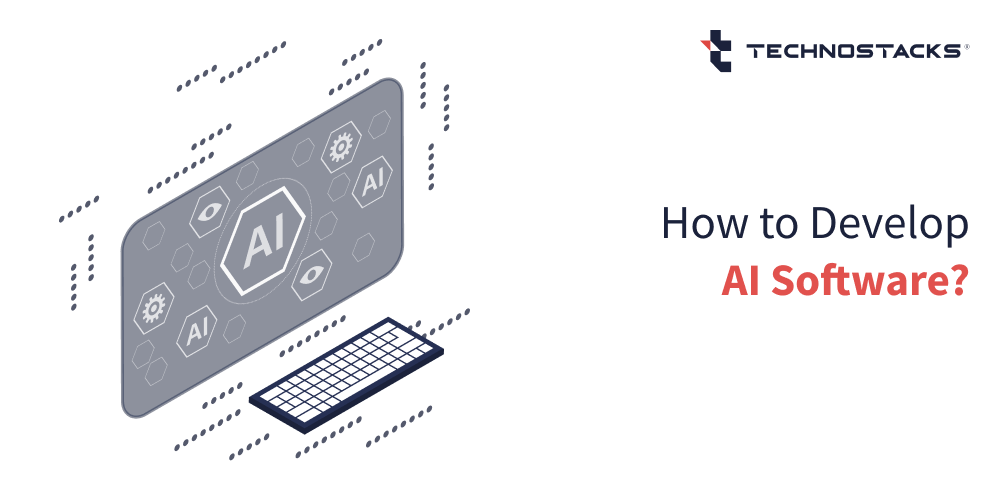How to Create AI Software?
If you want to attract your customer base, you should change your focus to create AI software. AI-powered software can automate your company’s processes, enhance decision-making, and assist you in attaining your set business objectives quickly.
AI software applications are already leveraged to analyze client behavior, forecast sales trends, automate promotional campaigns, and accomplish much more.
In this article, we will discuss how to create AI software, the requirements to create it, and an overview of AI statistics.
Global Artificial Intelligence (AI) Adoption
As per a precise report by PWC, AI adoption will reach up to $15.7 trillion in the global economy by 2030. Additionally, the worldwide AI software market size is projected to reach $126 billion by the year 2025.
AI algorithms can process big-sized data sets quicker than humans and offer more precise outcomes. For instance, AI-powered chatbots can successfully deal with client inquiries 24/7, freeing up human resources to work on more multifaceted and intricate tasks.
AI software and apps are already leveraged to automate tasks in diverse industry domains and analyze client or consumer actions to accelerate business activities.
With so many probable assistances, investing in AI software is an intelligent move for any startup exploring to gain a competitive edge. The leader in generative AI chatbots, OpenAI already provides human-like conversations for explicit applications.
The introduction of GPT-4 Turbo and its weight on refinement mark a significant swing in AI technology and solutions. The targeted user base can get ahead for more personalized and effective engagements, with probable impacts crossing from customer support to content generation.
Open AI statistics and reports showcase that more than 3 million people are already leveraging DALL-E to increase their overall creativity and boost workflows. With more than four million images generated daily, OpenAI facilitates DALL-E to be blended directly into applications and software products using their explicit API.
Statistics of AI Software
We will now explore AI related statistics, which will guide you on why you should build AI software and what is the future of AI software.
- The global AI market, which is $150.2 billion in 2023, is foreseen to rise to $1.35 trillion by 2030 at a precise compound annual growth rate (CAGR) of 36.8 percent, while the forecasted time period, as per a latest report by MarketsandMarkets on Artificial Intelligence (AI) industry and marketplace.
- With a more nearer forecast the global artificial intelligence (AI) market is forecasted to reach out $299.64 billion by the year 2026.
- Furthermore, as per Forbes, by 2023, the mainstream of global enterprises leveraging AI for digital commerce will attain at least a 25% improvement in client fulfillment, overall revenue or reductions in cost.
- The Comptroller and Auditor General of India (CAG), Girish Chandra Murmu, told that Artificial Intelligence can lead in contributions of around $15.7 trillion to the global economy by the year 2030. However, he also raised anxieties connected to its privacy and sustenance of ethics in financial audits.
- Around 91.5 percent of topmost businesses would like to invest in AI on a continuing basis. Also, with reference to one of the TechJury articles, around 35 percent of organizations are already utilizing AI globally and 42 percent of enterprises are exploring AI for its execution in the coming time.
- Even Gartner tells us that client gratification is likely to increase by around 25 percent by 2023 in companies that utilize AI.
- A leading IT analyst company, Info-Tech Research Group reports that around 44 percent of private sector firms are planning to deeply invest in AI systems in the year 2023.
How to Create an AI Software?
To develop your AI software system, there are specific steps you need to follow. So, we will explore how to create an artificial intelligence app and tips to make AI software in these steps.
Step 1 – Define a Precise Objective
Prior to coding your AI software, you must define what challenge or problem you want to resolve. AIs are explicitly trained to bring solutions to precise issues, and the less defined your challenge to solve, the more tough it is to develop your AI-based solution.
At this step, if you are going with your AI as a software product, you have to define your objective towards it. You need to set an objective which should comprise – what is the issue, and why is it an upright concept to invest in your AI software product to resolve it?
Step 2 – Collect and Clean the Involved Data Sets
As it is better said, that a model is only as effective as the data sets it was crafted with, so having the correct data to train your AI is enormously vital. What do we mean by the correct data set?
- The data is applicable to the issue you are attempting to resolve.
- There is adequate data to sufficiently signify all potentials and results.
- The data is completely fair and not biased.
Data comes in two comprehensive categories: structured and unstructured. Structured data is evidently defined information with modest search parameters – for instance, the content of an excel sheet. Unstructured data on the other side is intricate and cannot be analyzed straightforwardly – for instance, a transcript right from a conversation.
As all data scientists better know, data is barely ever structured. We have to clean the data and make it well-organized to derive sense from it. That same principle is applicable to an AI software or app. Getting the data sets ready by well-ordering the same, deleting partial data entries, and arranging it leads to precise cleaning of the data sets.
Step 3 – Form the Right and Unique Algorithm
No two AI software can be alike. A language learning model is diverse from a perception AI model. Neural networks, Natural Language Processing (NLP), deep learning, random forests, and symbolic regression are some of the scientific foundations of AI, each enabling their own functionality and resolving an explicit sort of issue.
For instance, neural networks are useful for precise predictive models, while KNN is developed for well-organization of data. The nature of the activity and the choice of your project will aid you evaluate what is the finest and right algorithm for your AI software development project.
Some leading organizations like Google provide pre-trained models ready to be personalized and directly deployed in the AI project. These are developed with millions of data entries and are more solid than what most of us are capable of achieving. So, rather training from scratch, you could leverage one of these ready services for effective outcomes.
Step 4 – Explicit Training of the Algorithm
An AI software requires learning its activity; this is what we say is the involved training of the algorithm. As a benchmark, most data scientists leverage 80 percent of their data set to train their artificial intelligence models, and the other 20 percent is utilized to assert the model’s predictive competencies.
So, the training process means that the AI classifies patterns in the data and makes a forecast that is likely based on said patterns.
Step 5 – Deploy the Final AI Software Product
With the AI software product thoroughly trained, it is a better time to refine the final details and software deployment. At this step, we must clearly define the user interface (UI) and its usage possibilities, and if it is a precise AI software service, we must create the brand across it. Also, as explained in Wiz’s guide on AI security, it’s important to take cyber threats into account at the point of final deployment. Whether intended for internal use or made available to third parties, your AI tool has to be adequately secure in order to prevent malicious actors from interfering with its inner workings and exposing sensitive assets or data.
Right from the automobile industry to the healthcare sector and day-to-day activities, AI software solutions are turning into a core technology in almost all industry areas, and with the sudden boost in interest and revenue likelihood, it is projected that new AI automation tools are evolving for programmers and non-programmers alike to create intelligent AI software solutions and scalable systems.
Top Benefits of AI Software For Businesses
Artificial Intelligence (AI) has effectively pushed the set boundaries of the approach computer machines used to run and functioned to make human lives simpler. AI is an immense structure of super computers which assists in enabling machines to work effortlessly and execute many human-like activities with more speed and consistency.
Thus, it can be stated to as a brilliant formation of next-generation advances and evolutions which leads to comprehensive automation and all-inclusive arrangement of numerous multifaceted operations and thus trims down human mistakes and errors.
There is no doubt about that AI-enabled software solutions have been able to transition diverse range of industries and domains through its several gains which it has to deliver in the following ways:
1. Dipping Human Faults and Errors
- AI-enabled computers make no mistakes if developed and programmed fittingly.
- AI models are based on analytical study thus leaving no possibility for faults.
- Assists to save time and involved resources for attaining precise and well-organized outcomes.
2. Automating Monotonous Activities and Processes
- AI facilitates automation of routine repetitive responsibilities in extents such as information gathering, data entry, email replies, application testing, invoice creation, and many more.
- The staff members get more time to concentrate and execute on such activities which need human capabilities.
3. Efficiently Dealing with Big Data and Analytics
- AI has all the assistances and algorithms to process and make inferences from big data in minimal time compared to humans taking more time and investment of efforts.
- AI has the capability to swiftly grasp and fetch applicable data sets which might be required for generating enhanced data analytics.
- AI can process sets of data and information by comprehending and better understanding them.
4. Enabling Swift Decision Making
- AI assists in collecting consistent and valued insights at a much speedier pace.
- AI, along with significant algorithms empowers machines to bring fused data and forecasts.
- AI systems are always accessible thus assisting in quicker business and operational decision making.
5. Working with AI-Driven Digital Assistants
- AI-based chatbots diminish the necessity for needless customer service staff members.
- Assists in resolving daily routine and straightforward client queries.
- Chatbots can intelligently manage customers and offer timely as well as precise information that is demanded.
- Instances of voice assistants include Siri and Alexa, which smartly respond to human voice directions and assist them in solving asked queries.
6. Executing Risky and Unsafe Tasks Proficiently
- AI apps can be easily leveraged in the industrial domains which are dangerous to human beings.
- AI systems reduce the risks involved in unsafe activities. For example, Robots are able to perform dangerous tasks such as coal mining, sea exploration, assist in rescue activities while natural calamities, and so on.
7. Enhancing Involved Procedures and Workflows
- AI assists organizations to work more competently, improves performance, and boosts revenues.
- Assists in refining monotonous procedures and provides enhanced workflows which are completely error and fault-free.
8. Helping in Healthcare Applications
- AI is directly involved in medical applications and health treatments.
- Healthcare professionals are able to forecast medical risks quickly using AI.
- AI helps in intricate treatment dealings like radiosurgery.
- AI based surgery stimulators track and identify neurological disorders
- AI even helps in stimulating and inspiring brain functions.
9. Allow Full-Time Accessibility
- AI based systems are obtainable 24*7 and can be used whenever needed at any given point of time.
- Distinct to humans, AI based solutions can be always creative and performance-driven.
- AI solutions are programmed to work for extended hours and can better deal with tiresome and dull tasks effortlessly.
Key Takeaways
We discussed how to build AI software and things to consider before developing AI software. We also explored examples of AI software solutions. So, now it is completely clear that AI software solutions have all the capabilities to exceed human intelligence and can execute specific activities much more precisely and proficiently.
There is also no doubt that AI software solutions hold massive potential which further benefits to craft an improved place to live in. However, whatsoever in surplus is not upright and nothing can be matched-up to the highly intelligent human brain.
At Technostacks, our developers discover groundbreaking approaches of leveraging artificial intelligence app development abilities to empower your business to deliver enhanced products, improve customer services and transition your business operations to meet the altering needs of your new and loyal customer base.
Our AI application developers craft modern-day algorithms that can assist your business take advantage of both structured and unstructured data sets that they gather from diverse range of business and operational activities. This assists businesses to precisely optimize their revenue streams.
If you are looking for build a artificial intelligence application then contact us. You can email us at info@technostacks.com or call us at +91-6351078408. Our team will contact you with a detailed explanation of your project requirements.
FAQs
1) Can I create my own AI software?
Yes, creating an AI software or app on your own is possible. However, it needs proficiency in AI tools, data science, and development languages such as Python and access to essential technology resources.
2) What software platform should I use to create an AI?
Google Cloud AI Platform is the finest AI development software solution. It backs powerful frameworks such as TensorFlow and Scikit-learn, which offer in-built and precise algorithms for diverse tasks. It also provides a highly scalable and friendly platform for developing, training and better-deploying machine learning models.
3) What is the cost of building AI software?
There are generally two categories of AI software solutions obtainable in the market: Custom AI solutions and pre-defined AI solutions as 3rd party AI software solutions. For a company exploring advanced AI software solutions, knowing the average range of AI software solution pricing is significant, which stays between $35,000 to $100,000. However, it depends on the complexity of features that impact the overall pricing.
4) How can AI software benefit your business?
AI software assists in making business and operational decisions quicker. Artificial intelligence solutions can aid businesses in making informed decisions that are more precise and dependable. For instance, an organization can utilize an AI-powered platform leveraging previous sales data to envision how many prospects will purchase your product.
5) How do I make an AI with Python?
If you want to enable an AI project with Python, many possibilities exist. This includes sentiment analysis through natural language processing (NLP), image recognition using machine learning algorithms, Chatbots using NLP and ML, applications involving recommendation engines, fraud detection and predictive analytics.
6) What are the steps of adopting AI in the business?
The below steps of adopting AI in business operations include:
- Get thoroughly acquainted with AI
- Identify problems and challenges you need to resolve
- Prioritize activities and value
- Know your competencies and abilities
- Bring in specialists
- Blend expertise levels
- Integrate data sets and insights
- Initiate a small project
- Continuously evaluate and precisely measure success
- Constantly evolve, grow, and mature
7) What are things that need to be considered when developing AI software?
The stuff required when developing an AI software or app includes precise infrastructure, security measures, AI-based integrations, AI productivity & performance, and evading favoritism. Creating an AI team focusing on data analytics, business intelligence (BI), data insights, and technology integration into present systems is also vital.








